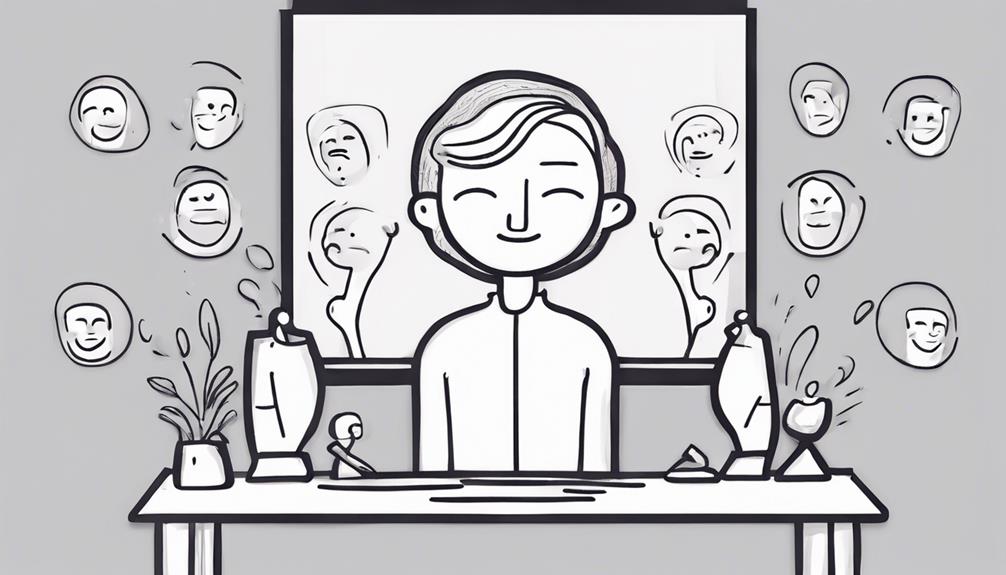Ready to break free from the self-improvement treadmill? It's time to shift focus from constantly perfecting yourself to embracing who you are. Recognize those self-obsessive patterns, like negative self-talk and seeking validation through accomplishments. Start small, acknowledge your strengths, and slowly build healthier habits. Practicing gratitude and self-compassion can work wonders in nurturing a more balanced and contented mindset. By letting go of shame, setting boundaries, and promoting positive self-talk, you pave the way for genuine self-acceptance. Take a step towards true well-being and growth by embracing your journey of self-discovery. Your path to self-fulfillment awaits.
Key Takeaways
- Acknowledge harmful self-obsession patterns hindering progress.
- Implement healthier habits for a balanced life.
- Examine thought processes and behaviors closely.
- Recognize seeking validation through achievements.
- Shift focus to positive aspects of self to break the cycle.
Recognizing Self-Obsession Patterns
Recognize self-obsession patterns by reflecting on behaviors that prioritize the self over others. Negative self-talk can be a red flag that you're overly focused on yourself.
If you catch yourself criticizing your every move or appearance several times a day, it's time to take a step back and evaluate your mindset. Instead of dwelling on flaws, try to shift your focus to the positive aspects of yourself.
Acknowledge your strengths and accomplishments, no matter how small they may seem. By doing this, you can start to break the cycle of self-obsession and cultivate a more balanced view of yourself and others.
Strategies for Breaking the Cycle

Okay, let's break this cycle of self-improvement obsession together.
First, acknowledge those harmful patterns that might be holding you back.
Then, let's work on implementing healthier habits that will help you move forward.
It's all about taking those small steps towards a more balanced and fulfilling life.
Identify Harmful Patterns
By examining your thought processes and behaviors closely, you can start uncovering the harmful patterns that perpetuate the cycle of self-improvement obsession.
Perhaps you find yourself constantly obsessed with things like listening to podcasts about self-improvement, seeking validation through achievements, or comparing yourself to others. These patterns can lead to a never-ending cycle of self-assessment, leaving you feeling inadequate and anxious.
It's important to recognize how this self-obsession hinders your ability to fully engage in life and experience joy in the present moment.
Breaking free from these harmful patterns involves acknowledging when these thoughts and behaviors arise. Take note of when you start feeling the need to constantly enhance yourself and question where these beliefs stem from. Are they rooted in societal pressures, past experiences, or unrealistic expectations?
Implement Healthier Habits
To break the cycle of self-improvement obsession, start implementing healthier habits that focus on self-care and balanced personal growth. Setting realistic goals for self-improvement is key to sustainable progress.
Create a well-rounded routine that includes physical exercise, mental relaxation techniques like meditation, and fostering social connections. Prioritize self-care activities such as journaling, hobbies, or simply taking time for yourself to break free from self-obsession.
Incorporating mindful practices like deep breathing exercises, gratitude journaling, or mindfulness meditation can help you stay grounded and focused on your well-being. Remember, seeking professional guidance or joining support groups can provide valuable accountability and encouragement along your journey towards adopting healthier habits.
Importance of Mindful Living

Let's talk about the importance of mindful living.
Being present in the moment can do wonders for reducing stress, improving focus, and boosting your overall well-being.
Mindful Living Benefits
Engaging in mindful living practices can greatly enhance your mental and emotional well-being. By being fully present in the moment, you not only sharpen your focus but also boost productivity in all areas of your life.
The reduction of stress and anxiety levels through mindfulness is like a soothing balm for your mind and soul. When you practice mindfulness, you heighten your self-awareness and gain better control over your emotions, leading to improved emotional regulation.
Moreover, the benefits of mindful living extend beyond individual well-being. Mindfulness cultivates a sense of gratitude, compassion, and overall life satisfaction. It allows you to appreciate the beauty in the simple things and approach life with a more positive outlook.
Cultivating Gratitude Daily
Cultivating gratitude daily in your life can greatly enhance your mental well-being and overall satisfaction with life. By taking a moment each day to reflect on the things you're grateful for, you shift your focus from self-obsession to appreciating the present moment.
This practice promotes positive emotions, reducing feelings of inadequacy and the constant need for improvement. Embracing gratitude fosters a sense of interconnectedness and fulfillment in your daily life, reminding you of the good things surrounding you.
When you acknowledge and appreciate these aspects, you develop a more balanced and contented mindset.
Practice Self-Compassion Techniques
Embracing self-compassion techniques through mindful living is important for breaking free from the cycle of self-improvement obsession. By incorporating these practices into your daily routine, you can cultivate a healthier relationship with yourself and foster a more balanced approach to personal growth. Here's why practicing self-compassion techniques is vital:
- Promotes Acceptance: Self-compassion techniques encourage you to embrace your imperfections and treat yourself with kindness, fostering a sense of self-acceptance and understanding.
- Counters Negative Effects: By practicing self-compassion, you can combat the harmful impacts of self-improvement obsession, allowing you to focus on holistic development rather than consistently aiming for unattainable perfection.
- Nurtures Self-Esteem: Engaging in mindful living and self-compassion techniques can boost your self-esteem and confidence, empowering you to navigate life's challenges with resilience and self-assurance.
Incorporating self-compassion into your daily life through mindful living can lead to a more fulfilling and content existence, free from the pressures of relentless self-improvement pursuits.
Finding Contentment and Balance

To find contentment and balance, prioritize living in the present moment and embracing satisfaction with personal growth. Let go of the constant need for self-improvement and appreciate the journey of personal development. Accept yourself as good enough and create a life filled with joy by focusing on gratitude and finding satisfaction in daily experiences. Shift your focus from constant improvement to enjoying the journey of self-discovery and growth.
| Key Steps to Finding Contentment and Balance |
|---|
| 1. Live in the Present Moment |
| Embrace the now and let go of worries about the future or past. |
| 2. Appreciate Personal Growth |
| Value your progress and accept yourself for who you are. |
| 3. Focus on Gratitude |
| Find joy in everyday experiences and cultivate a sense of thankfulness. |
| 4. Enjoy the Journey of Self-Discovery |
| Shift from striving for perfection to relishing in self-exploration and growth. |
Benefits of Overcoming Shame

Overcoming shame yields numerous benefits, enhancing various aspects of your life such as productivity, self-respect, and mental well-being. When you conquer shame, you open the door to a brighter future filled with increased productivity, a healthier sense of self-respect, and improved mental well-being.
Embracing this journey can bring about positive changes that ripple through every area of your life. Here are some benefits you can expect:
- Boosted Productivity: By letting go of shame, you free up mental space and energy that can be redirected towards accomplishing your goals.
- Enhanced Self-Respect: Overcoming shame allows you to see yourself in a more positive light, fostering a greater sense of self-worth.
- Improved Mental Well-Being: Releasing shame can lead to reduced stress, anxiety, and depression, promoting a healthier mindset and emotional state overall.
Impact of Shame on Self-Respect

Shame greatly impacts your self-respect by fostering negative self-talk and self-perception, ultimately hindering personal growth and creating feelings of unworthiness. When shame takes root, it acts as a relentless critic, constantly whispering harsh judgments about your worth and capabilities. This internal dialogue can erode your self-esteem, leaving you feeling inadequate and undeserving of success. As a result, you may find yourself hesitating to pursue opportunities, doubting your decisions, and setting lower goals than you deserve.
| Impact of Shame on Self-Respect | ||
|---|---|---|
| Hinders personal growth | Creates feelings of unworthiness | Damages self-esteem |
| Impacts decision-making | Affects goal-setting abilities | Reduces confidence |
| Diminishes productivity | Weakens relationships | Harms mental well-being |
It's essential to recognize the detrimental effects of shame on your self-respect and take proactive steps to combat its influence. By addressing negative self-talk, challenging distorted beliefs, and seeking support, you can begin to rebuild your self-esteem and cultivate a healthier sense of self-worth.
Strategies for Healing From Shame

Healing from shame involves actively practicing self-compassion and forgiveness as key steps towards reclaiming your self-worth.
It's crucial to challenge negative beliefs and thoughts that contribute to feelings of shame. By acknowledging these harmful patterns, you can start replacing them with positive affirmations and self-loving behaviors.
Remember, seeking therapy or counseling can provide you with professional support in overcoming shame, offering you strategies tailored to your specific needs.
Engaging in self-care activities and hobbies can also promote self-healing, allowing you to focus on activities that bring you joy and fulfillment.
Additionally, surrounding yourself with positive influences and support systems can aid in the healing process, reminding you that you're valued and deserving of compassion.
Moving Beyond Shame

To move beyond the grip of shame, it's imperative to acknowledge your past mistakes and embrace a mindset focused on personal growth. Healing from shame involves a journey of self-compassion, challenging negative beliefs, seeking therapy, practicing self-care, and surrounding yourself with positive influences.
Overcoming shame requires facing your past, focusing on evolving into a better version of yourself, setting boundaries with toxic relationships, accepting vulnerability, and building resilience.
The impact of shame on your self-respect can be profound, leading to negative self-talk, hindering your personal growth, fostering feelings of unworthiness, damaging your self-esteem, and clouding your decision-making abilities. Strategies for moving beyond shame include cultivating self-compassion, challenging negative beliefs, seeking professional help, engaging in activities that nurture you, and creating a supportive environment.
Importance of Positive Self-Talk

Let's chat about the power of positive self-talk and how it can boost your self-confidence.
By embracing affirming words and expressing gratitude for your self-improvement journey, you're laying a strong foundation for a healthier mindset.
Building Self-Confidence Through Talk
Regularly engaging in positive self-talk is essential for building self-confidence and improving overall well-being. The way you speak to yourself influences how you perceive your abilities and impacts the decisions you make. By embracing positive self-talk, you can enhance your emotional well-being and mental health, creating a more positive mindset for facing challenges.
Remember, self-respect and self-worth are closely tied to the conversations you have within yourself. Here are some ways positive self-talk can help you build self-confidence:
- Shaping Self-Perception: Positive self-talk shapes your self-perception, boosting your confidence in various aspects of your life.
- Enhancing Emotional Well-Being: Engaging in positive self-talk can lead to a more optimistic outlook, improving your emotional well-being.
- Improving Communication Skills: Positive self-talk not only boosts self-confidence but also promotes healthier relationships and communication skills, as it reflects how you interact with others.
Gratitude for Self-Improvement Journey
Engaging in positive self-talk is a vital tool for cultivating gratitude along your self-improvement journey. When you speak kindly to yourself, you shape how you perceive your abilities and boost your confidence levels. This positive self-talk not only influences your behaviors but also enhances your emotional well-being, creating a more supportive environment for growth.
As you navigate the path of self-improvement, building a network of support and practicing gratitude are essential in countering self-centered tendencies. By acknowledging your imperfections and challenging negative self-perceptions, you pave the way for increased self-confidence and personal development. Expressing gratitude further shifts your perspective towards interconnectedness and growth, reminding you of the progress you've made and the potential that lies ahead.
Signs of Obsession

Noticing signs of obsession with self-improvement is important for maintaining a balanced approach to personal growth. Sometimes, it's easy to get so caught up in becoming the best version of yourself that you lose sight of what truly matters.
Here are some signs to watch out for:
- Difficulty connecting with non-community members can be a red flag. If your focus on self-improvement is hindering your ability to form meaningful relationships outside of your self-improvement circles, it might be time to reassess your priorities.
- Obsessive checking of specific platforms may indicate a fixation on self-improvement. Constantly updating your feed for the latest tips and tricks might mean you're more fixated on improving yourself than actually enjoying the process.
- Interference with work or other goals due to self-improvement focus can be a warning sign. When your quest for self-betterment starts impacting your job performance or other important aspects of your life, it's important to take a step back and reevaluate your approach.
Frequently Asked Questions
How Am I Overcoming My Obsession With Constant Self-Improvement?
You're ditching the obsession with constant self-improvement by focusing on living fully each day. Engage in creating, reading, and connecting to break the cycle. Balance consuming self-help with actively living. Find joy in the journey.
How to Get Rid of Self-Obsession?
Shake off self-obsession like shedding old skin. Identify triggers, show yourself compassion, and seek joy beyond self-improvement. Embrace the present, seek support, and navigate the journey of self-discovery with openness and grace.
What Does It Mean to Be Obsessed With Improving Yourself?
You're consumed by the quest for betterment, fixated on enhancing every aspect of yourself. It's a cycle of chasing perfection, feeling inadequate, and prioritizing self-help over truly living. Remember, self-improvement should complement life, not overshadow it.
How to Get Rid of an Unhealthy Obsession?
You're stuck in a loop of obsession. Break free by changing your routine, ditching triggers, and understanding your deeper needs. Take a break, show yourself some love, and step out of the cycle.
Is It Necessary to Read Self-Improvement Books to Break Free from Self-Improvement Obsession?
When it comes to breaking free from self-improvement obsession, choosing your first book can make a significant impact. Reading self-improvement books can provide valuable insights and perspectives, but it’s important to strike a balance and not become overly fixated on constant self-improvement. Taking time to apply what you’ve learned is equally important.
Conclusion
To sum up, breaking free from self-improvement obsession is essential for finding true contentment and balance in life.
Did you know that 85% of people who focus on mindful living report feeling happier and more fulfilled?
By acknowledging detrimental patterns, embracing self-compassion, and transcending shame, you can truly flourish.
So, take a step back, breathe, and remember that you're already sufficient just as you are.
You've got this!










